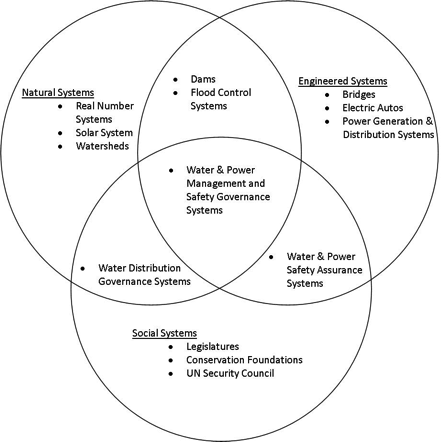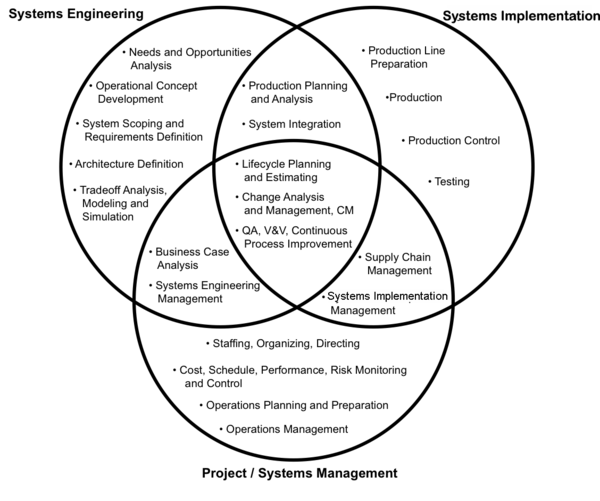Scope of the SEBoK
Scope of Systems Engineering within the Systems Domain
The scope of SE and the SEBoK must consider all classes of systems, but focuses on the domain of Engineered Systems. A convenient way to define the scope of Engineered Systems and the SEBoK is to relate it to the two other main systems domains, Natural Systems and Social Systems, as shown in Figure 1 below.
The nature and relationships of these system domains is discussed in Part 2 of the SEBoK. Part 2 considers the nature and purpose of systems generally, and how these ideas are used to ensure better engineered systems. It covers this by considering:
- System Thinking, a way of understanding complex situations by looking at them as combinations of systems. The paradox of systems thinking is that we can only truly understand a given system by considering all of its possible relationships and interactions, inside and outside of its boundary and in all possible future situations (of both system creation and life); but that this makes it impossible for people to understand a system or to predict all of the consequences of logical engineered changes to it.
- Systems Science, a collection of disciplines which have created useful knowledge by applying systems thinking to different aspects of the system domains. The system sciences provide us with a number of ways to deal with the system thinking paradox.
- Systems Approach, a way of tackling real world problems which makes use of the tools of system science to enable useful systems to be engineered and used. The key principle of the systems approach is that we must hide some of the detail of complex situations to allow us to focus on changes to a system element; but that we can consider the impact of any changes we might make across sufficient related system components to fit within acceptable commercial and social risks.
The systems approach requires understanding of both Natural and Socio Technical systems to identify and scope engineering system problems or opportunities and to ensure that engineered systems can be deployed into real world situations to achieve their goals while not adversely impacting on other outcomes.
The primary focus of the knowledge in SEBoK Parts 3 and 4 is on how to create or change engineered systems to fulfil the goals of all relevant stakeholders within these wider system contexts.
The knowledge in SEBoK Parts 5 and 6 consider the need for SE itself to be integrated and supported within the human activity systems in which it is performed and the relationships between SE and other engineering and management disciplines.
Scope of Systems Engineering (SE) within the Engineered Systems (ES) Domain
However, the scope of SE does not include the entire ES domain. Activities such as system construction, manufacturing, and their funding and management are similarly part of the SE environment, but (other than the management of the SE function) not a part of SE. As is reflected in the International Council on Systems Engineering (INCOSE) top-level definition of systems engineering (INCOSE 2010):
An interdisciplinary approach and means to enable the realization of successful systems,
SE can enable the realization of successful systems, but cannot ensure a successful realization if the systems’ funding, implementation, and manufacturing are poorly managed and executed.
Again, a convenient way to define the scope of SE within the ES domain is to develop a Venn diagram showing the relations among SE, SystremImplementation, and Project/Systems Management. Here also, activities outside the SE boundary are still important SE environment considerations, such as analyzing alternative methods for production, testing, and operations. Note that Software Engineering also includes the Software Construction parts of SystemImplementation. It is not a subset of Systems Engineering.
Traditional definitions of SE have emphasized sequential performance of SE activities, e.g., (INCOSE 2010): “…documenting requirements, then proceeding with design synthesis…”. For the SEBoK, we have emphasized the inevitable intertwining of system requirements definition and system design in the following revised definition of SE:
Systems Engineering (SE) is an interdisciplinary approach and means to enable the realization of successful systems. It focuses on holistically and concurrently understanding stakeholder needs; exploring opportunities; documenting requirements; and synthesizing, verifying, validating, and evolving solutions while considering the complete problem, from system concept exploration through system disposal.
Part 2 of the SEBoK, Systems, elaborates on the definition above and offers additional definitions and elaborations, providing further context for the rest of the SEBoK.
References
Citations
INCOSE. 2010. INCOSE systems engineering handbook, version 3.2. San Diego, CA, USA: International Council on Systems Engineering (INCOSE), INCOSE-TP-2003-002-03.2.
Primary References
All primary references should be listed in alphabetical order. Remember to identify primary references by creating an internal link using the ‘’’reference title only’’’ (title). Please do not include version numbers in the links.
Additional References
All additional references should be listed in alphabetical order.
Article Discussion
Signatures
--Nicole.hutchison 20:44, 16 August 2011 (UTC)

